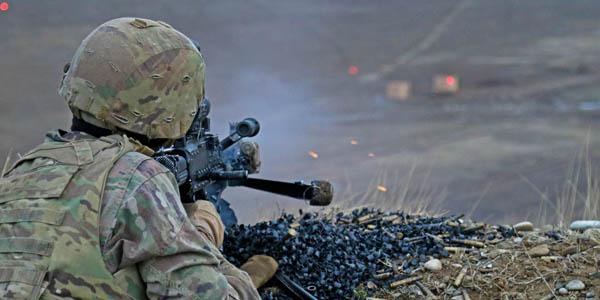Mobile Tech Comes to Warfighter Aid
The military continues to focus its efforts on developing the most sophisticated technologies and capabilities needed to sustain tactical advantage and achieve mission objectives. But the most critical component to success on the battlefield continues to lie with the warfighter.
Measuring real-time human health and performance is essential to keeping warfighters safe. Lt. Gen. Nadja Y. West, the 44th Army surgeon general and U.S. Army Medical Command commanding general, has focused on such efforts and recently called for new tools and capabilities that can help the Army better track soldier fitness on the battlefield.
Gen. West has emphasized the importance of using mobile solutions to harness real-time analytics on warfighter health data. “One benefit is being able to monitor the health and performance of deployed soldiers with real-time data streams. This is real data that can be used to provide real decision-making power to a commander on who he or she selects to go on the next missions,” she said. In fact, mobile technologies are central to transforming the way defense agencies aid warfighters in achieving mission-critical mission outcomes by collecting and providing information—all accessible in the palm of a hand or worn as part of a uniform.
Mobile Solutions Support for All Battlefield Stages
Mobile technologies, including smartphones, tablets and wearables, will play a critical role in helping defense agencies harness enhanced capabilities. Some innovative examples of how the Department of Defense (DOD) can deploy mobile solutions to monitor health and enhance performance in all stages of activities on the battlefield include:
Before the Fight: Enhance Warfighter Readiness
Mobile technologies like wearables can be used for biometric monitoring, such as measuring soldiers’ health through nutrition, exercise and sleep, and improved battlefield readiness.
For example, the Army recently doubled down on efforts to ensure warfighters are optimizing the performance triad (P3) of sleep, physical activity and nutrition, which optimizes physical fitness, cognitive dominance and emotional resilience. In conjunction with such efforts, the Army Research Institute of Environmental Medicine strapped wearable sensors on soldiers from the 75th Ranger Regiment, as they completed the first and second Ranger Assessment and Selection Program, at Fort Benning, Georgia. The purpose of the study was to predict heat illness in soldiers and use real-time physiological status monitors, keeping track of soldiers’ core and skin temperatures as well as heart rates. This will ultimately help researchers create a performance baseline and determine how the body responds when healthy and when experiencing heat illness or higher levels of stress so that they can better prepare future warfighters for taxing battlefield environments.
In the Fight: Minimize Injuries and Reduce Fatalities
It’s imperative that soldiers get the treatment they need in what is known as the golden hour—the precious 60 minutes following a battlefield wound when proper medical treatment can be crucial to a soldier’s survival. Mobile technologies can deliver faster, life-saving data, especially in a chaotic battlefield environment to ensure correct and necessary critical care information is available to sustain injured warfighters.
A group of U.S. Air Force researchers recently developed a new electronic patient monitoring tool for the battlefield called the Battlefield Assisted Trauma Distributed Observation Kit (BATDOK). BATDOK is software that runs on smartphones or other mobile devices and draws patient information from a wide variety of commercially available, U.S. Food and Drug Administration-approved sensors. This can let medics monitor multiple patients in the field, seeing vital information and managing multiple patients in a complex, tactical environment.
“BATDOK is a multipatient, point of injury, casualty tool that assists our human operators and improves care,” said Dr. Gregory Burnett of the Airman Systems Directorate in the Warfighter Interface Division of the 711th Human Performance Wing. “It can be a real-time health status monitoring for multiple patients, a documentation tool, a user-definable medical library, a portal to integrate patient data into their electronic health records, and finally, it is interoperable with battlefield digital situation awareness maps, which helps identify the exact location of casualties.”
After the Fight: Aid in Trauma Recovery
Mobile immersive technologies like virtual reality (VR), augmented reality and mixed reality are helping rehabilitate soldiers returning from the battlefield, including through treatment for posttraumatic stress disorder. These types of solutions can serve as a therapeutic tool for a variety of treatments including pain management.
Albert Rizzo, research professor at the USC Davis School of Gerontology, reported, “Exposure therapy is an ideal match with VR…You can place people in provocative environments and systematically control the stimulus presentation.”
Underpinned by advances in high-speed and high-bandwidth 5G networks, mobile will continue to enable incredible real-time analytics and data collection and new capabilities that will ensure soldiers can achieve peak health and performance on the battlefield. The military will be able to use mobile tools to enhance the health and performance of soldiers on the battlefield, ultimately improving agility, tactical operations and, most importantly, safety of the men and women who serve.
With over 27 years of experience in the defense, intelligence and transportation industries, Chris Balcik is vice president for federal sales, Samsung.





Comments